The transient absorption (TA) experiment allows quantitative characterization of time-dependent absorption of an optically excited sample. Two light pulses are required: femtosecond narrow-bandwidth pump pulse to excite the sample and delayed broad-bandwidth probe pulse to measure the changes in sample transmittance. The resulting difference absorption signal is measured as a function of probe wavelength and the temporal delay between the pump and probe pulses.
The TA spectrum is much more elaborate than, e.g., a steady-state absorption or fluorescence decay spectrum. It provides information not only on the excited states of the system but also on all the intermediate evolutionary transients and non-emissive states both on the ground and the excited states.
In HARPIA-TA, the TA experiment can be easily customized to get additional insight into the ultrafast dynamics of photoactive systems. For example, measuring transient reflection instead of absorption would provide more details on material surface photodynamics. Performing pump intensity-resolved absorption would help estimate the annihilation and saturation processes. Carrying TA experiments with different linear or circular pump pulse polarizations would allow obtaining molecular aggregation properties or molecular-level chirality-dependent spectra.
When the transient spectroscopy is not enough, the HARPIA-TA spectrometer can be expanded to perform time-resolved multi‑pulse and fluorescence spectroscopies using HARPIA-TB and HARPIA-TF modules, respectively.
- 高重复频率下性能优异
- 测量范围从紫外到中红外
- 行业领先的灵敏度
- 时间分辨和多脉冲实验模块
- 高度自动化,占地面积小
- 100 fs – 20 ps 连续可调脉宽
- 最大单脉冲能量 4 mJ
- 最小脉宽输出 < 100 fs
- POD 和 BiBurst 功能
- 高达 5 次谐波或可调谐扩展
- CEP 稳定或重复频率锁定
- 热稳定性和密封设计
- 190 fs – 20 ps 连续可调脉宽
- 最大输出 1 mJ @ 120 W 或 2 mJ @ 80 W
- 单脉冲 – 2 MHz 重复频率
- POD 和 BiBurst 功能
- 高达 5 次谐波或可调谐扩展
- 风冷型号
- 紧凑的工业级设计
- 190 nm – 16000 nm 可调波长
- 满足所有需求的高能量和高功率型号
- 单脉冲 – 2 MHz 重复频率
- 最高泵浦功率 80 W
- 最大泵浦单脉冲能量 2 mJ
Effect of intramolecular charge transfer processes on amplified spontaneous emission of D–π–A type aggregation-enhanced emission molecules
Y. Li, P. Han, X. Zhang, J. Zhou, X. Qiao, D. Yang, A. Qin, B. Z. Tang, J. Peng, and D. Ma, Journal of Materials Chemistry C 9 (11), 3284-3291 (2023).
Improved Crystallization of High-Solubility Non-Fullerene Electron Acceptors for Enhanced Photoelectric Conversion Efficiency: Effect of the Terminal Group
G. Ran, X. Shan, H. Lu, Y. Liu, Z. Bo, and W. Zhang, The Journal of Physical Chemistry C (2023).
Intramolecular and Intermolecular Interaction Switching in the Aggregates of Perylene Diimide Trimer: Effect of Hydrophobicity
P. Su, G. Ran, H. Wang, J. Yue, Q. Kong, Z. Bo, and W. Zhang, Molecules 7 (28), 3003 (2023).
Packing-induced selectivity switching in molecular nanoparticle photocatalysts for hydrogen and hydrogen peroxide production
H. Yang, C. Li, T. Liu, T. Fellowes, S. Y. Chong, L. Catalano, M. Bahri, W. Zhang, Y. Xu, L. Liu et al., Nature Nanotechnology 3 (18), 307-315 (2023).
Solution-grown BiI/BiI3 van der Waals heterostructures for sensitive X-ray detection
R. Zhuang, S. Cai, Z. Mei, H. Liang, N. Zhao, H. Mu, W. Yu, Y. Jiang, J. Yuan, S. Lau et al., Nature Communications 1 (14) (2023).
Atomic structure of a seed-sized gold nanoprism
Y. Song, Y. Li, M. Zhou, H. Li, T. Xu, C. Zhou, F. Ke, D. Huo, Y. Wan, J. Jie et al., Nature Communications 1 (13) (2022).
Charge Photogeneration and Recombination in Fluorine-Substituted Polymer Solar Cells
R. Hu, Y. Liu, J. Peng, J. Jiang, M. Qing, X. He, M. Huo, and W. Zhang, Frontiers in Chemistry 10 (2022).
Cobalt(III) Carbene Complex with an Electronic Excited-State Structure Similar to Cyclometalated Iridium(III) Compounds
N. Sinha, B. Pfund, C. Wegeberg, A. Prescimone, and O. S. Wenger, Journal of the American Chemical Society 22 (144), 9859-9873 (2022).
Completely Anisotropic Ultrafast Optical Switching and Direction-Dependent Photocarrier Diffusion in Layered ZrTe 5
S. B. Seo, S. Nah, M. Sajjad, J. Song, N. Singh, S. H. Suk, H. Baik, S. Kim, G. Kim, J. Kim et al., Advanced Optical Materials 3 (11), 2201544 (2022).
Effects of polyethylene oxide particles on the photo-physical properties and stability of FA-rich perovskite solar cells
R. K. Koech, Y. A. Olanrewaju, R. Ichwani, M. Kigozi, D. O. Oyewole, O. V. Oyelade, D. M. Sanni, S. A. Adeniji, E. Colin‑Ulloa, L. V. Titova et al., Scientific Reports 1 (12) (2022).






